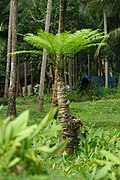Note: This is a project under development. The articles on this wiki are just being initiated and broadly incomplete. You can Help creating new pages.
Phoenix pusilla
Phoenix pusilla (pusilla, Latin, tiny or weak) or Ceylon date palm is a species of flowering plant in the palm family, endemic to southern India and Sri Lanka (formerly Ceylon), they are found in lowlands, ridges and hills. No taller than 5 m, this species is usually single-stemmed but clumps do occur naturally.
Contents
[hide]- 1 Uses
- 2 Parts Used
- 3 Chemical Composition
- 4 Common names
- 5 Properties
- 6 Habit
- 7 Identification
- 8 List of Ayurvedic medicine in which the herb is used
- 9 Where to get the saplings
- 10 Mode of Propagation
- 11 How to plant/cultivate
- 12 Commonly seen growing in areas
- 13 Photo Gallery
- 14 References
- 15 External Links
Uses
Bladder stones, Piles, Fevers, Dysentery, Rectal prolapses, Urinary tract infections, Cough.
Parts Used
Chemical Composition
Moisture, 66.7%; total soluble solids, 18.42%; sugars, 18.42 (mostly reducing)%; vitamin C, 9.42 mg per hundred g; pectin, 0.51%; protein, 1.12%; ash, 3.261%; phosphorus, 0.042%; potassium,. 0.549%; calcium, 0.139% magnesium, 0.006% and iron, 0.007%. [1]
Common names
| Language | Common name |
|---|---|
| Kannada | |
| Hindi | |
| Malayalam | Eentha, Chitteenthal |
| Tamil | Cittintu, இசம Icham |
| Telugu | |
| Marathi | NA |
| Gujarathi | NA |
| Punjabi | NA |
| Kashmiri | NA |
| Sanskrit | Parusakah |
| English | Ceylon Date Palm |
Properties
Reference: Dravya - Substance, Rasa - Taste, Guna - Qualities, Veerya - Potency, Vipaka - Post-digesion effect, Karma - Pharmacological activity, Prabhava - Therepeutics.
Dravya
Rasa
Guna
Veerya
Vipaka
Karma
Prabhava
Habit
Identification
Leaf
| Kind | Shape | Feature |
|---|---|---|
| Simple | linear in outline | Leaves are up to 3 m long; pseudoleaf-stalk up to 70 cm long x 1.5-3 cm wide at base, rounded abaxially; leaf bases persistent, vertically orientated on trunk, about 8 cm wide at base. |
Flower
| Type | Size | Color and composition | Stamen | More information |
|---|---|---|---|---|
| Bisexual | Ovoid | Yellow-white | Calyx 1-1.5 mm high; petals 4-5 x 2-3 mm ovate, with rounded apices |
Fruit
| Type | Size | Mass | Appearance | Seeds | More information |
|---|---|---|---|---|---|
| Simple Fruit | Ovoid | 11-15 x 5-8 mm | Ripening from green to red to purple-black | {{{6}}} |
Other features
List of Ayurvedic medicine in which the herb is used
Where to get the saplings
Mode of Propagation
How to plant/cultivate
A plant of the drier, lowland tropics, where it is found at elevations up to 700 metres. Plants can tolerate some frost. Requires a sunny position in a well-drained soil. Tolerant of some salt in the soil. [3]
Commonly seen growing in areas
Photo Gallery
References
External Links
- Ayurvedic Herbs known to be helpful to treat Bladder stones
- Ayurvedic Herbs known to be helpful to treat Piles
- Ayurvedic Herbs known to be helpful to treat Fevers
- Ayurvedic Herbs known to be helpful to treat Dysentery
- Ayurvedic Herbs known to be helpful to treat Rectal prolapses
- Ayurvedic Herbs known to be helpful to treat Urinary tract infections
- Ayurvedic Herbs known to be helpful to treat Cough
- Herbs with Fruits used in medicine
- Herbs with common name in Malayalam
- Herbs with common name in Tamil
- Herbs with common name in Sanskrit
- Herbs with common name in English
- Habit - Tree
- Index of Plants which can be propagated by Seeds
- Herbs that are commonly seen in the region of Garden area
- Herbs
- Arecaceae




